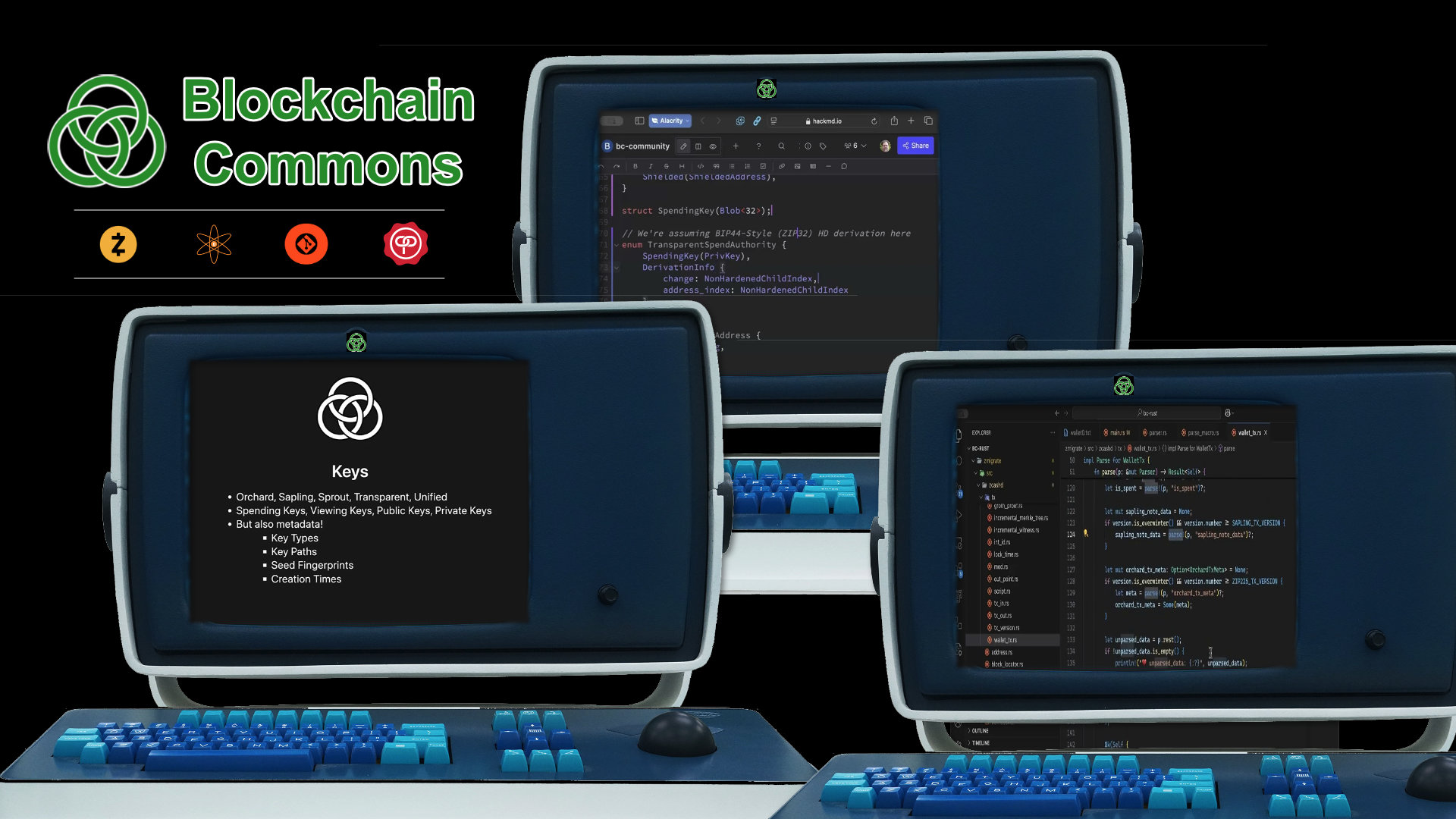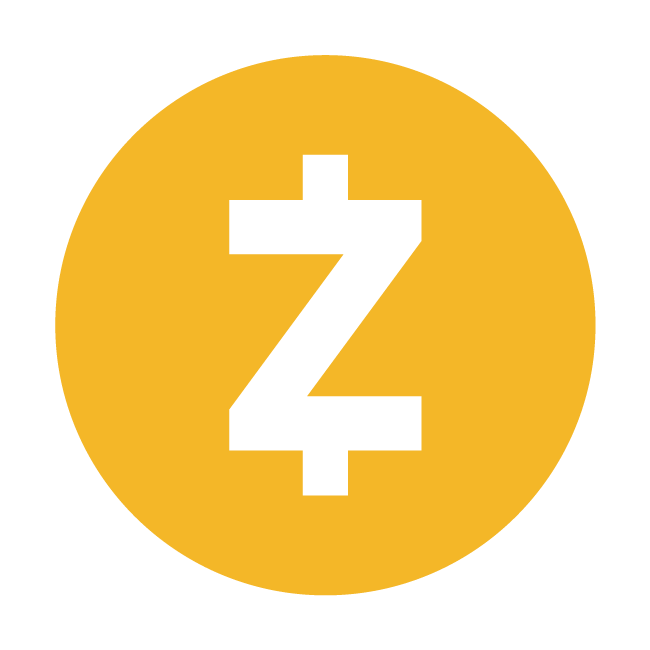2025 Q1 Blockchain Commons Report

Blockchain Commons focused on the ZeWIF project for the Zcash blockchain during the first quarter of 2025, but that didn’t stopped us from also advancing a few other priorities, including the initial release of our long-incubating Open Integrity project. Here’s what all we’ve been working on.
ZeWIF Specification:
- Why It’s Important
- The ZeWIF Meetings
- What We’ve Released So Far
- What’s Still to Come
Post-Quantum Commons:
- Why It’s Important
- PQC Meeting
- QuantumLink
- What We’ve Released So Far
Open Integrity:
- Why It’s Important
- What We’ve Released So Far
New Articles:
- The Right to Transact
- SSI Orbit Podcast
New Dev Docs:
- SSKR Pages
- UR Pages
- Meetings Pages
- Improved Crate Docs
New Ports:
- Lifehash to Rust
New Research:
- Provenance Marks
- Provenance References
ZeWIF Specification

The Zcash extensible Wallet Interchange Format (ZeWIF) has been Blockchain Commons’ main priority since the Zcash Community Grants program approved our proposal at the end of the year.
Why It’s Important. Blockchain Commons talks a lot about interoperability, and that’s what ZeWIF is: it’s a way to freely exchange data between Zcash wallets in a standardized form. What we don’t talk about as often is why interoperability is important.
It goes back to our Gordian principles. Interoperability supports at least three of them.
- It supports independence because any user can freely move their data among the interoperable software systems.
- It supports openness because any developer can easily join the ecosystem by adopting a mature, well-understood specification. This creates an environment of coopetition (cooperative competition) that leads to advances in technology and usability.
- It supports resilience because the interoperable format makes data less likely to be lost: it’ll be in a form that will be understood and therefore accessible, well in the future.
For a wallet ecosystem, interoperability means that users will have the freedom to move their digital assets among Zcash wallets. That’s the precise independence we want users to have, which is why it’s been worth spending a few months of time on this project.
The ZeWIF Meetings. To support the ZeWIF project, Blockchain Commons held three meetings in the first quarter: on the initial wallet survey, on the first demo of the zmigrate tool, and on ZeWIF data abstractions. Meeting with developers to ensure that specifications serve everyone’s needs has always been a bedrock policy for Blockchain Commons, so we’ve of course extended it here. (At least one more meeting is planned, for April 16th, to demo the data file format.)
|
#1: Wallet Survey:
|
#2: Zmigrate demo:
|
#3: Abstraction Discussion:
|
What We’ve Released So Far. The ZeWIF project is built around the zewif library, which stores Zcash wallet data in an in-memory format. We’ve also written zewif-zcashd and zewif-zingo to demonstrate the import of data from those wallets to ZeWIF, while our partners at Zingo Labs have produced “zewif-zecwallet” for importing zecwallet data (though that PR hasn’t been merged yet). Finally, we authored zmigrate, which is a demo CLI for importing zcashd content. With these demos and libraries in hand, other wallet developers can start working to interchange their own data via the ZeWIF format.
What’s Still to Come. With our releases so far, data can be interchanged between different Zcash wallets as long as it’s all done on the same machine: you just import into the in-memory ZeWIF format from one wallet, then export to another. But we expect most use cases will instead involve at least two different machines. That’s where the ZeWIF file format comes into play. Building on Gordian Envelope, it translates the ZeWIF in-memory storage into a fixed file that can then be moved to a different machine. We expect to demo the Envelope ZeWIF format at that upcoming April 16th meeeting.
Post-Quantum Commons

Is Post-Quantum Cryptography (PQC) the next big thing? We were able to support our friends at Foundation with some PQC work just as we got the ZeWIF project going at the start of the year.
Why It’s Important. Quantum Computers are starting to appear, and though they’re far, far from what would be needed to break cryptography at the moment, there’s no telling when there’s going to be a sudden “quantum” leap. Though today’s cryptography might not need PQC, if you’re working on something that might be around for 5 or 10 years, you should be thinking about it!
PQC Meeting. Our March Gordian meeting contained all the details of our PQC work, including what Quantum Computing is.
QuantumLink. The highlight of the meeting was a discussion of QuantumLink from our friends at Foundation. This is a quantum-resistant protocol for Bluetooth communication that is a critical component of their new Passport Prime wallet. It allows them to use Bluetooth with high security and for that security to remain strong 5 or 10 years in the future, in case Quantum Computing does make those big strides forward.
What We’ve Released So Far. The QuantumLink technology was enabled by new PQC support that Blockchain Commons incorporated into its libraries. You can now use the PQC algorithms ML-DSA and ML-KEM in our Rust stack, from bc-componenents on up.
Open Integrity

We had one other big release in Q1: Open Integrity, a system for increasing the trust of software being developed in Git. Well, technically it was released on April 7th, the 20th anniversary of Git’s release, but this is something that Blockchain Commons Architect Christopher Allen has been working on for about a year, so we’re thrilled to get the word out.
Why It’s Important. We wrote a whole article discussing why Open Integrity is important. But, in short: Git repos are growing increasingly important for the deployment of critical software, and Git doesn’t actually provide a high-level of trust for those repos, despite the ability to sign commits. Open Integrity bridges the gap betwen what Git offers and what online software distribution needs.
What We’ve Released So Far. The Open Integrity project is now available in an early form at GitHub. A Problem Statement offers details on the issues we’re trying to solve and our solutions. We’ve also got a number of tools and scripts, the most import of which creates an inception commit on a repo. This inception commit is the root of trust that lays the foundation for ensuring that you always know who’s in control of a repo.
If you want to try out Open Integrity, see the Open Integrity Snippets file, which has complete instructions on how to get that inception-commit script running, plus many examples that will allow you to experiment with Open Integrity.
That’s it for our big Q1 projects, but we had a number of smaller releases over the course of the quarter as well.
New Articles
The Right to Transact. We think the right to transact should be an international freedom. Read more in Christopher’s recent article, “The Case for an International Right to Freedom to Transact”, which builds on his 2024 musing, “How My Values Inform Design”.
SSI Orbit Podcast. Christopher also was interviewed for the SSI Orbit Podcast. It’s been nine years since he wrote the foundational “Path to Self-Sovereign Identity”. Where do things stand today?
New Dev Docs
SSKR Pages. We updated our SSKR dev pages with the big focus being differentiating SSKR URs (where you split up a key) and SSKR Envelopes (where you protect the entire contents of an Envelope by creating and splitting up a key). The test vectors also now demonstrate both cases.
UR Pages. We similarly did some big updates to our UR dev pages. Here the issue was that URs had seen some changes over the years, especially as we locked down CBOR tag registration, and our examples were no longer up-to-date. Now, every page and every test vector should be correct. There’s also a new page on URs for Gordian Envelope.
Meetings Pages. All of Blockchain Commons’ meetings are now documented on a new meetings page, which also includes subpages with videos and slides (and usually transcripts) of everything from the last few years!
Improved Crate Docs. Finally, we’ve used some lessons learned from the documentation of ZeWIF to improve the documentation of our Rust stack. As a result, docs.rs now has improved docs for bc-dcbor, bc-components, and bc-envelope
New Ports
Lifehash to Rust. Lifehash is now available in a new Rust Implementation courtesy of Ken Griggs. Lifehash is a critical element of the object identity block, which can help users to recognize seeds and keys. We hope this will allow for more deployment.
New Research
Provenance Marks. One of our newest innovations, courtesy of Blockchain Commons Lead Researcher Wolf McNally, is the provenance mark. The provenance mark is a cryptographically secure chain of marks that facilitates the easy verification of authenticity. We’ll have more on them in the months ahead, but in the meantime, you can read Wolf’s research paper on the topic!
Provenance References. If you want to start playing with provenance marks right now, we’ve already released a series of reference apps and libraries. They include our original Swift implementation, our newer Rust implementation, and a CLI that can be used to create and manage marks!
That’s it for the moment. For the next quarter, we’ll be closing out our initial work on ZeWIF in April, and we’ll be offering more looks at Provenance Marks in the months ahead.
If you’d like to work with us on these or other topics, drop us a line about becoming a Blockchain Commons partner.
